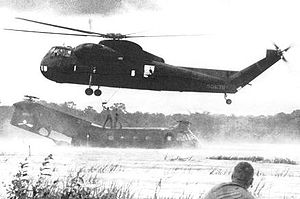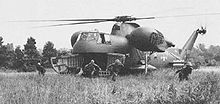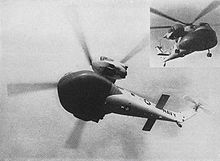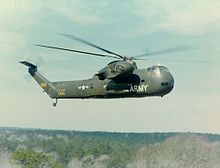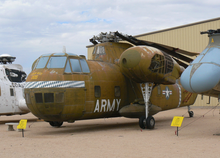- Sikorsky CH-37 Mojave
-
CH-37 Mojave CH-37 Mojave attempting to lift a crashed Piasecki H-21. Role Cargo helicopter Manufacturer Sikorsky Aircraft First flight 1953 Introduction July 1956 Retired Late 1960s Primary users United States Army
United States Marine CorpsNumber built 154 Developed into Sikorsky S-60 The Sikorsky CH-37 Mojave (company designation S-56) was a large heavy-lift helicopter by the standards of the 1950s.
Contents
Design and development
The S-56 came into being as an assault transport for the United States Marine Corps (USMC), with a capacity of 26 fully equipped troops; the order was placed in 1951, the first prototype flew in 1953, and production deliveries of the HR2S began in July 1956 to the Marine Corps' HMX-1, sixty aircraft in total being produced.
The United States Army evaluated the prototype in 1954 and ordered 94 examples as the CH-37A, the first being delivered also in summer 1956. All Marine and Army examples were delivered by mid-1960. Army examples were all upgraded to CH-37B status in the early 1960s, being given Lear auto-stabilization equipment and the ability to load and unload while hovering. In the 1962 unification of United States military aircraft designations, USMC examples became CH-37C.
At the time of delivery, the CH-37 was the largest helicopter in the Western world, and it was Sikorsky's first twin-engined helicopter. Two Pratt & Whitney R-2800 Double Wasp radial engines were mounted in outboard pods that also contained the retractable landing gear. This left the fuselage free for cargo, which could be loaded and unloaded through large clamshell doors in the nose. The single main rotor was five-bladed, and designed to function with one blade shot away in combat.
The CH-37 was one of the last heavy helicopters to use piston engines, which were larger, heavier and less powerful than the turboshafts subsequently employed. This accounted for the type's fairly short service life, all being withdrawn from service by the late 1960s, replaced in Army service by the distantly related CH-54 Tarhe.
Four CH-37Bs were deployed to Vietnam in 1963 to assist in the recovery of downed U.S. aircraft. They were very successful at this role, recovering over US$7.5 million worth of equipment, some of which was retrieved from behind enemy lines.
Variants
- XHR2S-1
- Prototype Assault Transport for the US Marine Corps, powered by two 1,900 hp (1,400 kW) R-2800-54 engines, four built.
- HR2S-1
- Production model with modified engine nacelles, twin mainwheels and dorsal fin, redesignated CH-37C in 1962, 55 built (order for additional 36 cancelled).
- HR2S-1W
- Airborne early warning aircraft for the US Navy, two built.
- YH-37
- One HR2S-1 helicopter evaluated by the US Army.
- H-37A Mojave
- Military transport version of the HR2S for the US Army, changes included dorsal fin and modified rotor head fairing, redesignated CH-37A in 1962, 94 built.
- H-37B Mojave
- All but four of the H-37As were modified with a re-designed cargo door, automatic stabilization equipment and crashproof fuel cells. Later redesignated CH-37B.
- CH-37A
- H-37A redesignated in 1962.
- CH-37B
- H-37B redesignated in 1962.
- CH-37C
- HR2S-1 redesignated in 1962.
- S-56
- Sikorsky company designation for H-37.
Derivatives
- S-60
- a prototype "sky-crane" with a skeletal fuselage with a crew cockpit at the front.
- Westland Westminster
- Westland Aircraft used the S-56 physics and the rotor and gearbox as the basis for the Westminster. with a tubular frame and the Napier Eland turboshaft for power.
Operators
Survivors
- CH-37B (#55-644) is on display at the U.S. Army Aviation Museum in Ozark, Alabama.
- CH-37B (#56-1005) "Tired Dude" is on display at the Pima Air Museum in Tucson, Arizona.
- CH-37B (57-1651) is owned by the U.S. Army Transportation Museum at Ft. Eustis, Virginia.
- CH-37B (58-0999) is on display at the Evergreen Aviation & Space Museum in McMinnville, Oregon.
- CH-37C (#145864) is on display at the National Museum of Naval Aviation in Pensacola, Florida.
Specifications (CH-37 Mojave)
Data from U.S. Army Aircraft Since 1947 [1]
General characteristics
- Crew: 3
- Capacity: 26 troops or 24 stretchers
- Length: 64 ft 3 in[2] (19.59 m)
- Rotor diameter: 72 ft 0 in (21.95 m)
- Height: 22 ft 0 in (6.71 m)
- Disc area: 4,080 ft² (379 m²)
- Empty weight: 20,831 lb (9,469 kg)
- Max takeoff weight: 31,000 lb (14,090 kg)
- Powerplant: 2 × Pratt & Whitney R-2800-54 Double Wasp radial engine, 2,100 hp (1,583 kW) each
Performance
- Maximum speed: 130 mph (113 kn, 209 km/h)
- Cruise speed: 115 mph
- Range: 145 mi (126 nmi, 233 km) with maximum payload
- Service ceiling: 8,700 ft (2,650 m)
- Rate of climb: 910 ft/min [3] (4.6 m/s)
See also
- Related development
- Sikorsky S-60
- Sikorsky CH-54 Tarhe
- Westland Westminster
- Aircraft of comparable role, configuration and era
- CH-53 Stallion
- Related lists
References
- Harding, Stephen. U.S. Army Aircraft Since 1947. Shrewsbury, UK:Airlife Publishing, 1990. ISBN 1-85310-102-8.
- Swanborough, F.G. and Peter M. Bowers. United States Military Aircraft since 1909. London:Putnam, 1963.
External links
- CH-37 Mojave US Army Aviation history fact sheet
- Information and Specs on the H-37
- Photos of CH-37's from 49th Avn Bn, CAL ARNG, and others
Sikorsky Aircraft Fixed-wing aircraft S-1 · S-2 · S-3 · S-4 · S-5 · S-6 · S-7 · S-8 · S-9 · S-10 · S-11 · S-12 · S-13 · S-14 · S-15 · S-16 · S-17 · S-18 · S-19 · S-20 · S-21 · S-22 · S-23 · S-24 · S-25 · S-26 · S-27 · S-28 · S-29-A · S-30 · S-31 · S-32 · S-33 · S-34 · S-35 · S-36 · S-37 · S-38 · S-39 · S-40 · S-41 · S-42 · S-43 · VS-44 · S-45
Helicopters
(Company designations)Helicopters
(Military designations)Experimental aircraft USAAC/USAAF/USAF/Joint Service Helicopter designations 1941– Numerical sequence used by USAAC/USAAF/USAF 1941–Present; US Army 1948–1956 and 1962–present; US Navy 1962–presentMain sequence
Prefix R-, 1941–1948
Prefix H-, 1948–1962
H- with a mission prefix 1962–presentR-1 • R-2 • R-3 • R-4 • R-5/H-5 • R-6/H-6 • R-7 • R-8 • R-9/H-9 • R-10/H-10 • R-11/H-11 • R-12/H-12 • R-13/H-13/OH-13/UH-13J • R-14 • R-15/H-15 • R-16/H-16 • H-17 • H-18 • H-19/UH-19 • H-20 • H-21/CH-21 • H-22 • H-23/OH-23 • H-24 • H-25/UH-25 • XH-26 • H-27 • H-28 • H-29 • H-30 • H-31 • H-32 • H-33 • H-34/CH-34 • H-35 • (H-36 not assigned) • H-37/CH-37 • (H-38 not assigned) • XH-39 • H-40 • H-41 • H-42 • H-43/HH-43 • (H-44 and H-45 not assigned) • CH-46/HH-46 • CH-47 • UH-48 • H-49 • QH-50 • XH-51 • HH-52 • CH-53/HH-53/MH-53 • CH-54 • TH-55 • AH-56 • TH-57 • OH-58 • XH-59 • UH-60/SH-60/HH-60 • YUH-61 • XCH-62 • YAH-63 • AH-64 • HH-65 • RAH-66 • TH-67 • MH-68 • (H-69 not assigned) • ARH-70 • VH-71 • UH-72
1962 redesignations
reusing old numbersUSN helicopter designations pre-1962 Helicopter, Anti-submarine SikorskyHelicopter, Crane HCHHelicopter, Observation HillerHOESikorskyHelicopter, Trainer pre-1948 SikorskyHelicopter, Trainer 1948-1962 HillerHelicopter, Transport 1944-1962 Boeing VertolHRHSikorskyHelicopter, Utility pre-1949 HJDHJHSikorskyHJSHelicopter, Utility 1950-1962 HUK • HU2K
Bell:HUMSikorskyLists relating to aviation General Aircraft (manufacturers) · Aircraft engines (manufacturers) · Airlines (defunct) · Airports · Civil authorities · Museums · Registration prefixes · Rotorcraft (manufacturers) · TimelineMilitary Accidents/incidents Records Categories:- Military helicopters
- United States military transport aircraft 1950–1959
- Military aircraft of the Vietnam War
- United States helicopters 1950–1959
- Sikorsky aircraft
Wikimedia Foundation. 2010.

